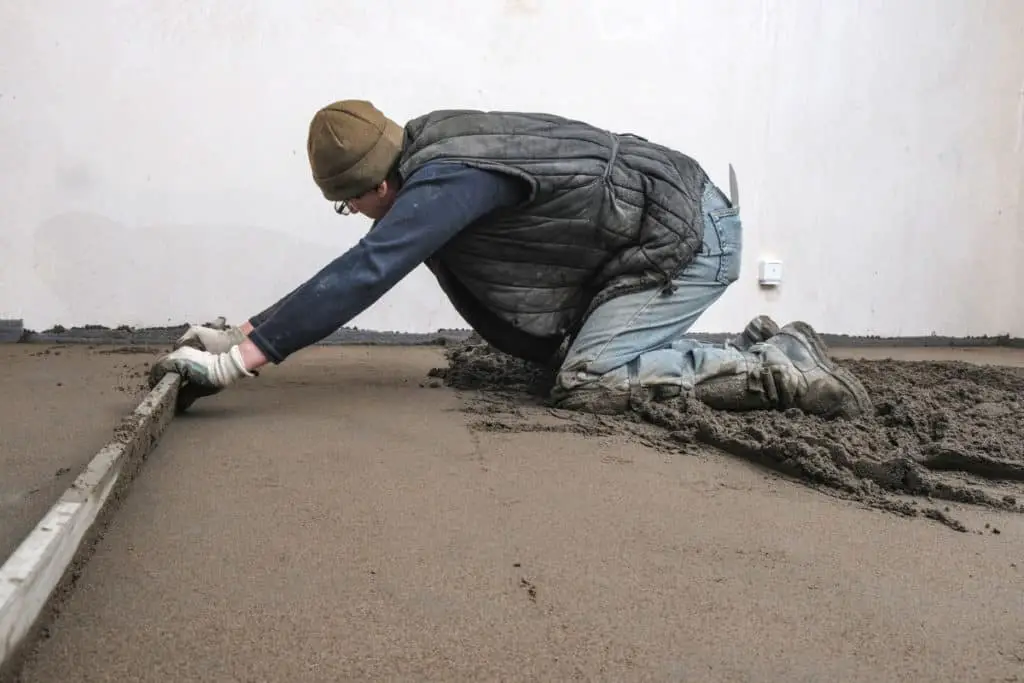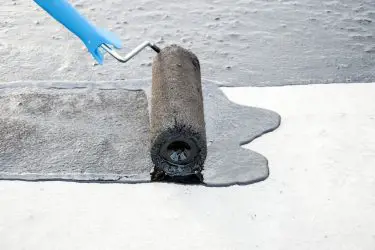Fast setting concrete is super convenient in a lot of situations. Being able to leave a fencepost alone after only 30 minutes is really nice when working on a new fence. This means you won’t have to hold it up or find support for it for a long period of time.
Quikrete Fast-Setting Concrete is as strong as regular concrete, reaching a strength of 4000 PSI after 28 days of curing. However, there are high-strength concrete mixes that will reach 5000 PSI and more. Quikrete Fast-Setting Concrete is most suitable for smaller projects, like setting fence posts.
If Fast-setting concrete is the same strength as ordinary concrete, then what’s the difference between them?

Table of Contents
What’s the Difference Between Quikrete and Regular Concrete?
Quikrete is a brand that offers different concrete mixes for different purposes. For example, they offer high-strength concrete mixes, like the Quikrete Concrete 5000 or the Quikrete Q•Max Pro as well as the regular all-purpose concrete mix Quikrete Concrete Mix. However, the mix most people referring to when talking about Quikrete is their Popular Fast-Setting Concrete Mix.
The difference between Quikrete Fast-Setting Concrete and regular concrete is the time it takes to set. The former sets rapidly, which is great for small applications but not ideal for bigger projects. Quikrete is just as strong as regular concrete and is made of the same main ingredients, but regular concrete is cheaper.
Let’s dig a little deeper into the differences and similarities of Quikrete and other concrete mixes.
Quikrete Fast-Setting Concrete is More Expensive
This is the most important distinction between fast-setting and regular concrete. A 50lb bag of fast-drying Quikrete costs an entire dollar more than the equivalent in regular concrete.
While for small projects this may be a negligible amount, it can add up very quickly.
Because of this, the economical choice is almost always to use regular concrete rather than Quikrete. Even a few square feet can take more than five bags of concrete to pave.
With quick-setting concrete that can add up fast, especially considering the sheer amount of concrete that’s needed to fill even a small space.
Related Article: How Many Bags of Concrete Equal a Yard?
Concrete is measured by its volume and its weight. 1 cubic foot of concrete weighs about 150lbs. That means to fill up a space the size of nine subway footlongs arranged into the frame of a cube, you would need 150 lbs of concrete.
And because concrete usually needs to be at least 3 inches deep, it doesn’t take that much space to end up filling a cubic foot. This means that even a project that looks small at the beginning can end up needing hundreds of pounds of concrete, and using fast-setting concrete will cost you an extra dollar for every fifty pounds you need.
With that said, it’s usually not recommended to use fast-setting concrete for larger projects.
Therefore, the price difference will normally not be that big if you choose to buy Quickrete Fast-Setting Concrete instead of a regular concrete mix.
The most common use for fast-setting concrete is probably setting fence posts in concrete without mixing, but one fencepost will usually need at least 50lbs worth of concrete.
This means that to set up just ten fenceposts in fast-setting concrete, you’ll be paying ten dollars than you usually would.
I think it’s definitely worth it considering the time you will save on the project, but if you want to save some bucks instead, choose the regular concrete.
Related Article: How Many Bags of Concrete for a Fence Post?
Quikrete Fast-Setting Mix Sets in Only 20-40 Minutes
The whole thing with Quikrete Fast-Setting Concrete is, of course, the quick drying times.
Regular concrete sets hard in about 24-48 hours, while fast-setting concrete sets hard in only 20-30 minutes. That’s a significant difference, but remember that both types of concrete aren’t fully cured until after about 28 days.
The concrete will not reach its full strength before it has fully cured. The main advantage of fast-setting concrete is that it reaches a higher level of strength in a shorter period of time. With that said, the total strength will be the same as the regular concrete when both have fully cured.
Why Is Quikrete So Quick?
When we speak of the hardening process for concrete, we often use the term drying. However, that isn’t entirely accurate. What’s actually happening is a little bit more complex than that.
As I mentioned earlier, concrete gets its strength from a chemical reaction between cement and water. This reaction is known as “curing.” In normal concrete, curing can take weeks or even months.
However, Quikrete is made using a certain amount of extra cement. This speeds up the reaction significantly, making the concrete harden much faster. There are likely other chemical accelerants involved in the process as well, but Quikrete only lists them as “special cements,” so we don’t know what they are specifically.
Sakrete (another brand that offers a fast-setting concrete mix) gives about the same amount of information. Whatever they’re using is apparently a secret, but if nothing else at least we know that whatever it is, isn’t making the concrete dry slower.
An interesting side effect of the curing process being so much faster is that fast-setting concrete can get a bit hotter than ordinary concrete.
Curing is what’s known as an exothermic reaction. That means that one of the byproducts of the reaction is heat. This is true for all concrete, which is why it can sometimes randomly get warm the first few weeks after it’s been poured.
However, the speed at which the concrete cures can affect just how hot it gets. If it uses slow-curing cement, its heat can be limited by quite a bit. If it has faster-curing cement, it will get warmer.
This is usually harmless. Even while concrete is curing, it won’t usually get hot enough to hurt people unless the ambient temperature is very high. Even when it is very hot outside, it’s extremely unlikely to get hot enough to burn anything.
When to Use Quikrete Fast-Setting Mix and When You Shouldn’t
Even though fast-setting concrete might seem great looking at the drying times, there are situations where you shouldn’t use it.
But let’s start discussing the situations where you definitely should consider using fast-setting Quikrete.
Setting fence posts in concrete is absolutely a project you should use fast-setting concrete for. It’s extremely convenient and makes the job so much easier and faster.
You don’t even have to mix the concrete before you pour it into the hole! Just add the right amount of concrete powder and pour the water over it. It’s as simple as that!
For more detailed instructions on doing it, you should check out our article ‘How To Set a Post in Concrete Without Mixing‘.
Or you could just watch this short video to get an idea:
Really, any smaller-scale projects can make good use of fast-setting concrete, especially if you don’t need more than 200 lbs of the mix.
Here are some more situations when fast-setting concrete is ideal:
- All types of posts (mail box, basketball post, etc.)
- Air Conditioner Pads
- Deck Supports
It can also be nice if you need to pour concrete, but you know it will get cold soon, as cold usually interrupts the curing process. With quick-setting concrete, the concrete can be used lightly even if it hasn’t had a chance to really cure.
Regular concrete, on the other hand, will be better for mid-sized projects and projects that aren’t time-sensitive. Pouring a part of a new sidewalk, for instance, should probably be done with regular concrete to save money and to make the project less stressful.
You have to remember that you only have 20-40 minutes to get everything perfect until the fast-setting concrete becomes hard.
A patio would also likely be larger than you would want to use fast-setting concrete for, as it might be hard to get it right in such a short amount of time.
If you are not benefitting from the faster drying times, it’s only an extra unnecessary cost to use fast-setting concrete.
Regular concrete is also better in hotter weather, where the concrete will set quicker than usual no matter what kind it is. However, if it’s too hot while you’re pouring concrete, it can have adverse effects on the long-term strength of the slab.
It’s generally best to avoid all temperature extremes when it comes to pouring concrete.
Related article: Pouring Concrete in the Cold: How to ensure it won’t crack
Similarities Between Fast-Setting Concrete and Regular
Fast-drying concrete is the same as ordinary concrete in almost every way. Aside from setting speed, if you can think of something about concrete, it probably applies to fast-setting concrete as well. This is because they are essentially the same substance.
Mixing, pouring, and floating fast-setting concrete is not different from doing those things to ordinary concrete in any substantive way, except that they must be done a little bit quicker to accommodate for the faster curing speed.
If you plan on using fast-setting concrete, be ready to get these things done quickly. Aside from that, treat it the same way you’d treat any other concrete pour.



